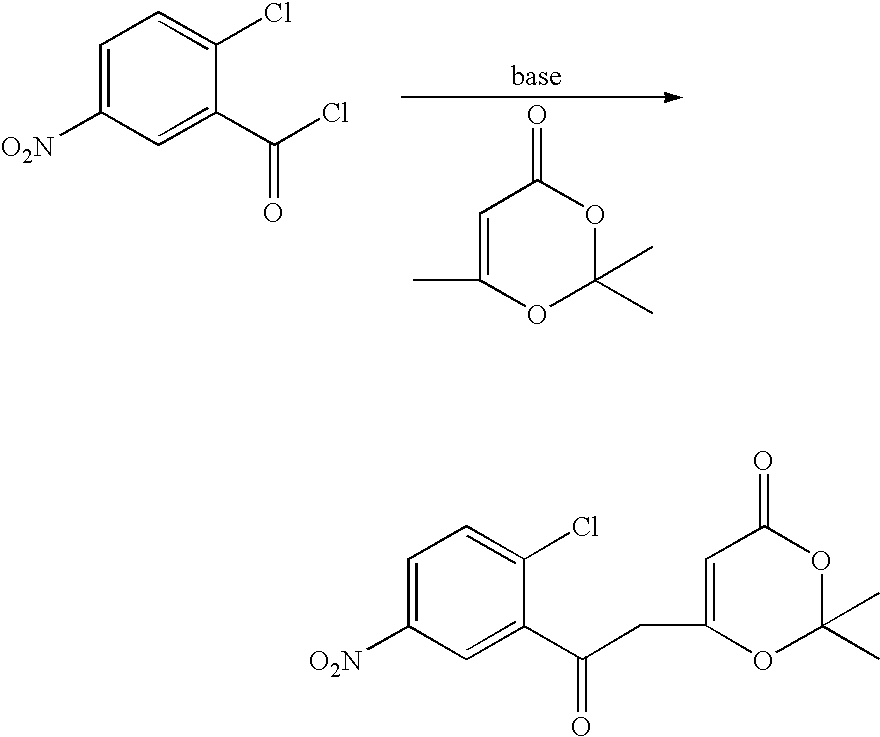Methods for producing amino substituted chromanes and intermediates therefor
- Summary
- Abstract
- Description
- Claims
- Application Information
AI Technical Summary
Benefits of technology
Problems solved by technology
Method used
Image
Examples
example 1
Production of 2-chloro-5-nitrobenzoyl chloride
To a 3 L 3 neck round bottom flask equipped with a mechanical stirrer, nitrogen inlet, reflux condenser, heating mantle, vacuum system, and scrubber system for efficient removal of HCl and SO2 gas which is liberated during the reaction, was charged, under nitrogen, 1.0 L (1.63 Kg, 13.7 moles) of thionyl chloride, and 1.3 Kg (6.4 moles) of 2-chloro-5-nitrobenzoic acid. The stirred mixture was placed under a N2 flow, which was vented to the scrubber system. The stirred mixture was heated to reflux for 12 hours during which time the reaction slowly becomes complete. The clear yellow solution was placed under vacuum and excess thionyl chloride was removed by evaporation under vacuum. The resulting slurry was dissolved in 800 mL of toluene, and concentrated to dryness by evaporation under vacuum. The resulting yellow solid was dried at about 50° C. and about 20 mm Hg for about 4 hours to give 1.35 Kg of 2-chloro-5-nitrobenzoyl chloride as a...
example 2
Production of 6-[2-(2-chloro-5-nitrophenyl)-2-oxoethyl]-2,2-dimethyl-1,3-dioxine-4-one) (1))
To a dried 1 liter 3 neck round bottom flask equipped with a mechanical stirrer, nitrogen inlet, 500 mL addition funnel, cooling system, thermowell, was charged under nitrogen, 300 mL of anhydrous THF, and 38.3 g (0.27 moles) of 2,2,6-trimethyl-1,3-dioxin-4-one (acetonide). The stirred reaction was cooled to about −60° C. and 240 mL of 1.5 M lithium diisopropylamide was added through the addition funnel. The addition funnel was rinsed with 25 mL of anhydrous tetrahydrofuran. The orange solution was stirred for 1.0 hours at −70° C. The addition funnel was charged with 40 g of 2-chloro-5-nitrobenzoyl chloride (acid chloride) dissolved in 50 mL of anhydrous THF. The acid chloride / THF solution was added to the reaction at a rate which maintains the reaction temperature<−60° C. (addition time=about 1 hour). The dark orange reaction solution was stirred for 0.5 hours and then cooling was rem...
example 3
Production of 6-[2-(2-chloro-5-nitrophenyl)-2-oxoethyl]-2,2-dimethyl-1,3-dioxine-4-one) (1))
To a dried 3 liter 3 neck round bottom flask equipped with an overhead stirrer, nitrogen bubbler, condenser, a 1 L addition funnel, cooling system, thermowell, was charged under nitrogen, 600 mL of anhydrous THF, and 40.2 g (0.250 moles, 88.2% pure) of 2,2,6-trimethyl-1,3-dioxin-4-one (acetonide). The dark solution was stirred and cooled to about −70° C. via acetone-dry ice bath and then 358 mL of 1.3 M lithium hexamethyidisilylazine (LiHMDS) (0.466 moles) was added over a 30 minute period. The LiHMDS was added at a rate which kept the temperature below −50° C. The dark solution was stirred for 1 hour while cooling to −65° C. and then 50.0 g of 2-chloro-5-nitrobenzoyl chloride (0.227 moles, acid chloride) dissolved in 60 mL of anhydrous THF was added to the reaction at a rate which maintains the reaction temperature<−50° C. (addition time=about 30 minutes). The dark orange reaction sol...
PUM
 Login to View More
Login to View More Abstract
Description
Claims
Application Information
 Login to View More
Login to View More - R&D
- Intellectual Property
- Life Sciences
- Materials
- Tech Scout
- Unparalleled Data Quality
- Higher Quality Content
- 60% Fewer Hallucinations
Browse by: Latest US Patents, China's latest patents, Technical Efficacy Thesaurus, Application Domain, Technology Topic, Popular Technical Reports.
© 2025 PatSnap. All rights reserved.Legal|Privacy policy|Modern Slavery Act Transparency Statement|Sitemap|About US| Contact US: help@patsnap.com



